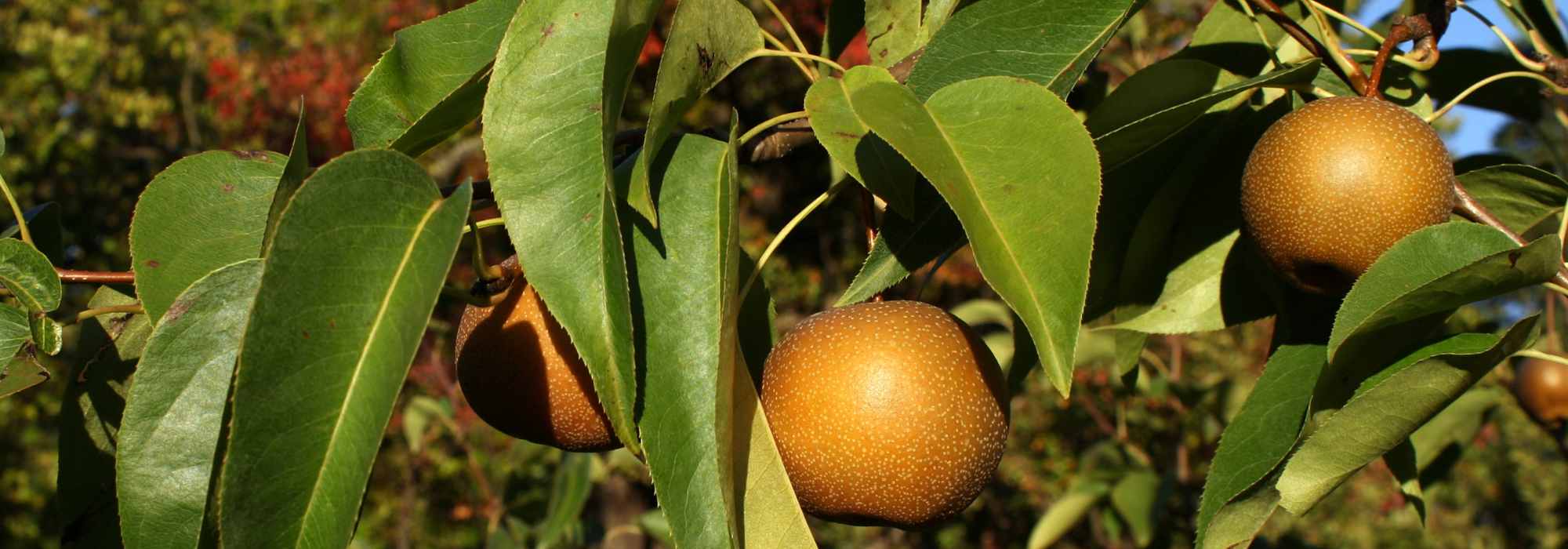
Nashi or Japanese pear: planting, harvest
Contents
The Nashi or Asian pear in a few words
- This is an exotic fruit tree, a cross between a pear and an apple
- It produces fruits called nashis, which resemble apples with juicy, crisp flesh and a pear-like flavour
- It is disease-resistant, hardy against cold, and thrives in sunny spots in any good, non-calcareous soil
- You need to plant a pear tree or another variety of nashi to ensure fruit production
- Nashis are harvested in late summer and can be stored for several months
The word from our expert
The Nashi or Japanese pear tree (Pyrus pyrifolia) is a small fruit tree, the Asian cousin of our common pear tree. Native to Japan and China, it is still relatively uncommon in our orchards, where it was only introduced in the 1980s. It rewards us at the end of the season, from August onwards, with golden or bronzed fruits resembling apples, dotted with white lenticels. Their crisp flesh reveals a refreshing flavour, fragrant and juicy, and offers numerous health benefits.
Compact in size, this Japanese pear tree forms a small tree, not exceeding 3 to 5 metres in any direction. It thrives in fresh, fertile soil but dislikes overly chalky ground. Hardy down to around -15°C, it can be grown in any garden. The Nashi pear tree is not self-fertile; you will need to plant another pear tree (such as William’s) or another variety of Nashi to ensure fruit production. Discover how to grow these delicious Asian pears and cultivate the Nashi tree!
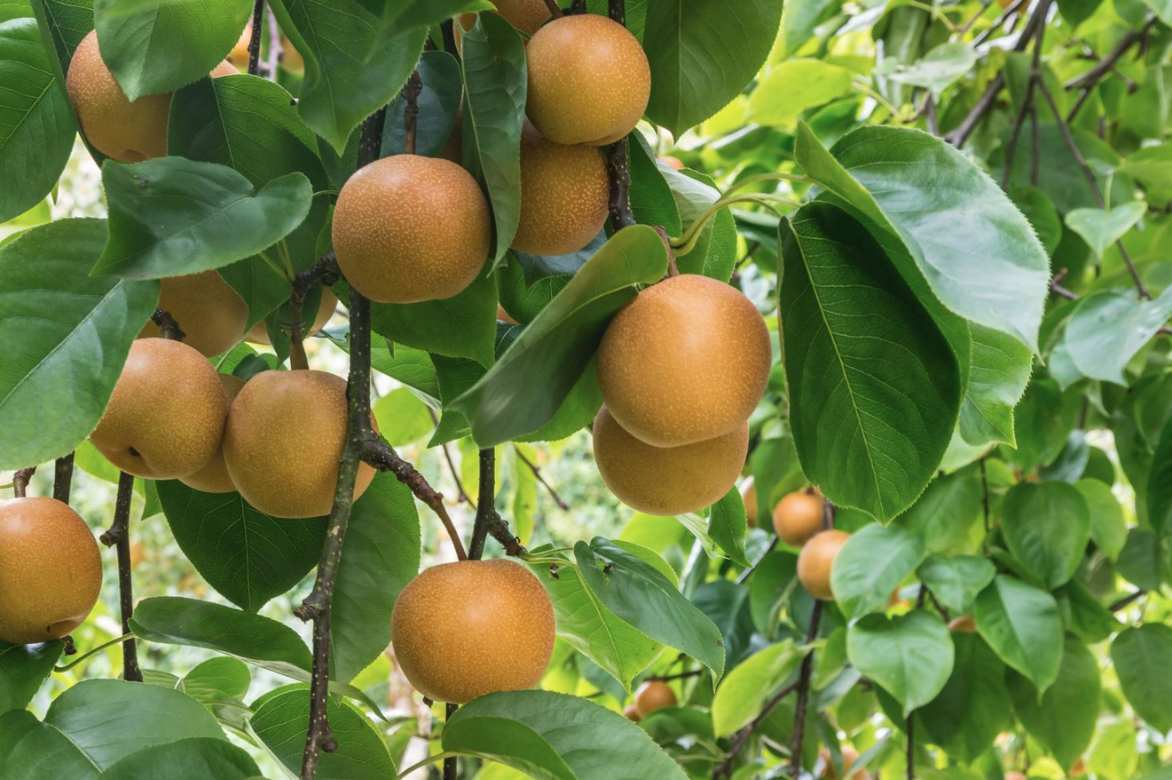
Description and Botany
Botanical data
- Latin name Pyrus pyrifolia
- Family Rosaceae
- Common name apple-pear, Asian pear, Japanese pear
- Flowering April
- Height 3 to 5 m
- Exposure Sun
- Soil type Rich, fresh, well-drained
- Hardiness -15 °C and beyond
The Nashi or nachi, more commonly known as the apple-pear, sand pear, or Asian pear, is a fruit tree belonging to the Rosaceae family, like the pear tree, almond tree, peach tree, or apple tree. The nashi is a pear tree, although its almost round fruits resemble apples. It is derived from the wild pear species Pyrus pyrifolia. Native to Asia, mainly the mid-mountain regions of Japan, South Korea, and China, it grows in temperate to subtropical climates at altitudes between 100 and 1400 metres.
It is still rarely found in our orchards. The species was introduced and cultivated in France only from the 1980s, particularly in the Landes and Aveyron regions, as the tree tolerates frosts only down to -15°C. It is also found in Italy. Today, there are many cultivars resulting from cross-breeding with common pear varieties Pyrus communis, with varying skin, flavour, and ripening times. Most require cross-pollination by the common pear tree.
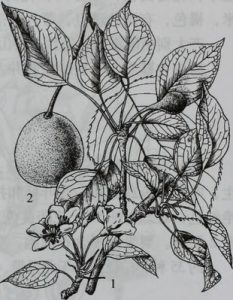
It forms a small tree, not exceeding 5 metres in height, with a tall and slender silhouette, making it suitable for many gardens. From a tall trunk, the branches naturally spread over time, making harvesting easier and improving the tree’s aeration. The branches are longer than those of the pear tree it resembles, arching gracefully. Its slightly weeping habit makes it a beautiful specimen when planted alone.
The alternate leaves are simple, ovate, and finely dentate on the margins. They measure about 10 to 12 cm, slightly larger than those of the common pear tree. They are borne on a petiole almost as long as the lamina, rustling at the slightest breeze. This deciduous foliage, glossy green, turns beautiful yellow to red hues in autumn before falling.
The nashi’s flowering occurs late, in April, between that of the peach and pear trees, usually protecting it from frost. The flowers are typical of the Rosaceae family, remarkably decorative in spring. They consist of five white-pink petals, with a bouquet of red stamens surrounding the pistil at the flower’s centre. Measuring 3 to 4 cm wide, they appear in clusters at the ends of the shoots and attract many pollinating insects. These flowers are not self-fertile, so another pear tree nearby is necessary for good fruiting. The William’s and Nashi Kosui varieties are renowned for being good pollinators for all varieties.
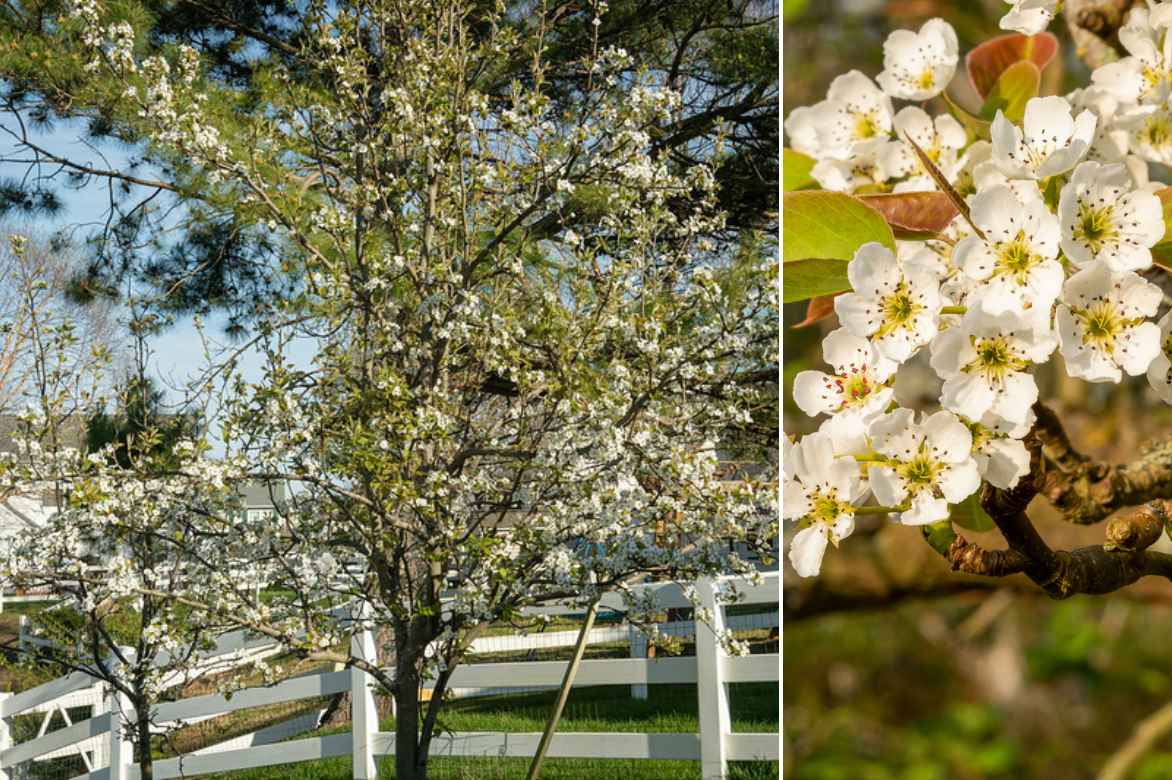
Pyrus pyrifolia: habit (© Puddin Tain), and flowering in April
The flowers are followed by the formation of apple-like fruits, hence its other names of apple-pear or pear-apple. “Nashi” means “pear” in Japanese. Many fruits, more or less globose and flattened, about 7 cm in diameter, appear on one-year-old shoots. Nashis vary in size and colour depending on the variety. The fruit’s epidermis is more or less rough. The skin is bronzed, ochre-red, or yellow, dotted with white lenticels. Nashis resemble apples while having the texture of pears. These fleshy fruits reveal granular, crunchy, and juicy flesh, particularly refreshing. Their flavour is a subtle blend of apple and pear, less sweet than that of classic pears and slightly acidic. When ripe, the fruits emit a sweet scent and remain as firm to the touch as an apple. Harvesting takes place from mid-August to October, depending on the variety and climate. It begins to produce 2 or 3 years after planting.
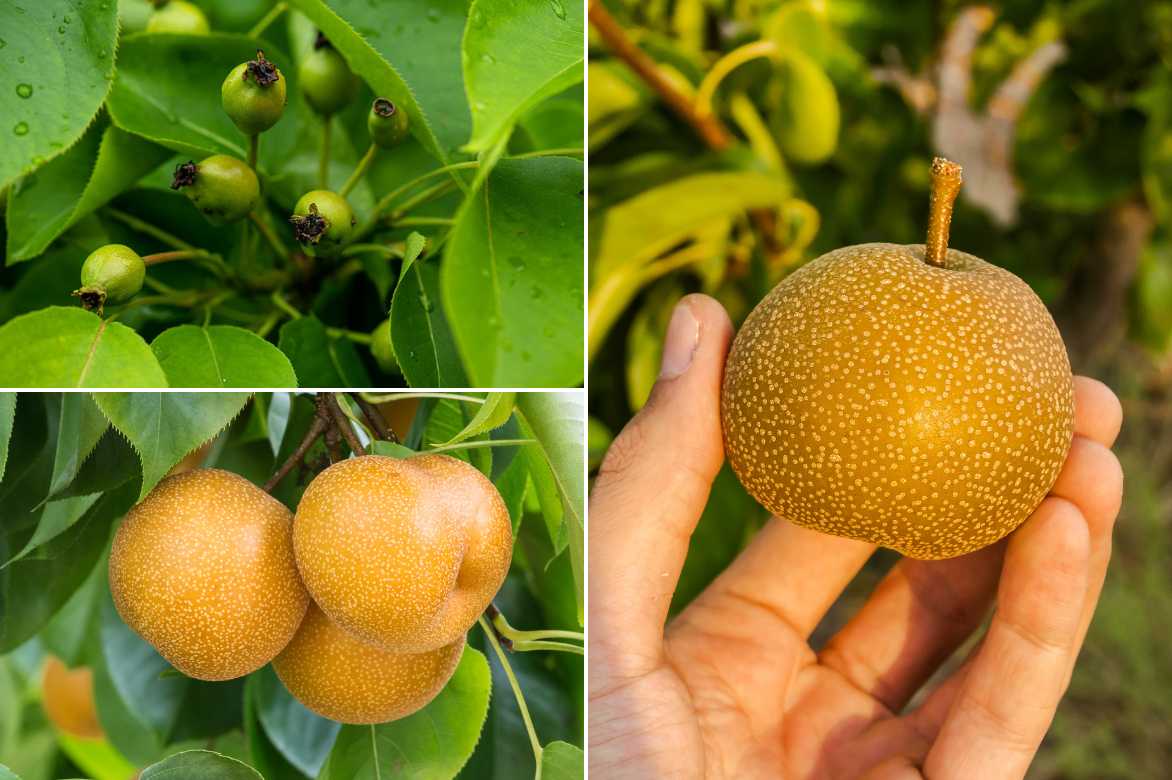
Young Nashi fruits (© Puddin Tain), and ripe fruits ready to pick
Main species and varieties
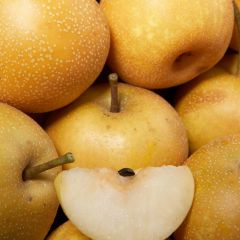
Nashi Hosui Abundance - Apple-Pear
- Flowering time May
- Height at maturity 5 m
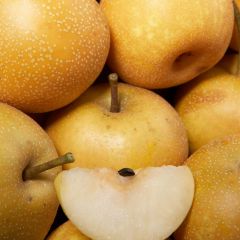
Nashi Hosui - Apple-Pear
- Flowering time May
- Height at maturity 4 m
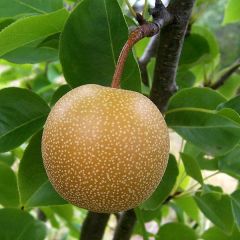
Nashi Shinseiki Organic - Apple-Pear
- Flowering time April, May
- Height at maturity 4,50 m
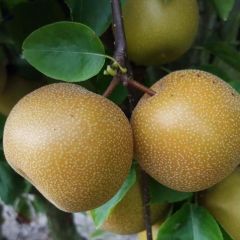
Nashi Nijisseiki - Apple-Pear
- Flowering time April, May
- Height at maturity 3 m
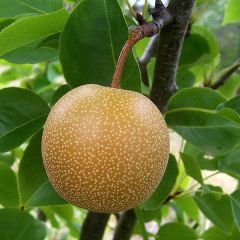
Nashi Shinseiki - Apple-Pear
- Flowering time April, May
- Height at maturity 4,50 m
Discover other Asian Pear trees
View all →Available in 1 sizes
Available in 1 sizes
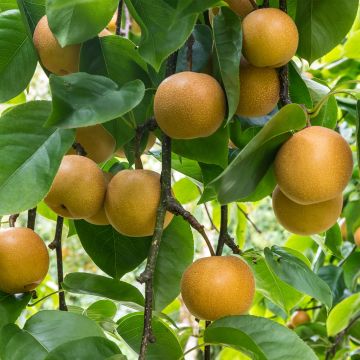
Available in 1 sizes
Available in 1 sizes
Available in 1 sizes
Available in 1 sizes

Available in 1 sizes
Available in 1 sizes
Available in 1 sizes
Available in 1 sizes
Planting a nashi pear tree
Where to Plant a Nashi?
Hardy down to -15-20°C, once well established, the Nashi tree tolerates winter cold very well and can adapt anywhere in France, including at low altitudes. This fruit tree requires cold and sunlight to bear fruit. Care should be taken with its positioning, choosing a sunny spot sheltered from prevailing winds. As it needs warmth, it should be planted away from cold winds, for example against a well-exposed wall, especially north of the Loire.
The Japanese pear tree thrives in any good garden soil—rich, moist but without waterlogging, and well-drained. It prefers soils that are neither too dry nor too chalky. It requires another variety of nashi or a pear tree (pollinator) nearby to ensure good fruiting. The Williams pear tree has a spreading flowering period, making it ideal for pollinating nashi species.
It naturally fits into an orchard but also works well in ornamental gardens at the back of a border or as a standalone feature, thanks to its slender, slightly weeping habit and delicate flowering. Like the Apple tree and the pear tree, the nashi can be grown as a free-standing tree or trained against a wall.
When to Plant the Nashi?
Nashi trees are ideally planted in autumn between October and March, avoiding frost periods. If container-grown, they can be planted year-round, except during extreme heat or frost.
How to Plant It?
If planting multiple nashi trees, space them at least 4 to 6 metres apart. The nashi prefers moist but not waterlogged soil. If your soil retains water, improve drainage with gravel or compost. It has a clear preference for acidic or neutral soil.
- Prepare the soil by removing stones and weeds
- Soak the root ball in a bucket of water for a few minutes before planting to rehydrate it thoroughly
- Using a spade, dig a hole about 60 cm in diameter and depth
- Add a layer of drainage at the bottom, especially if your soil is heavy
- Place compost at the bottom of the hole
- Position the root ball and insert a stake
- Place the young plant with the collar level with the soil surface
- Fill in with a mix of garden soil and compost, ensuring the root ball is completely covered
- Firm the soil around the base and water generously to eliminate air pockets
- Secure the stake with a suitable tie
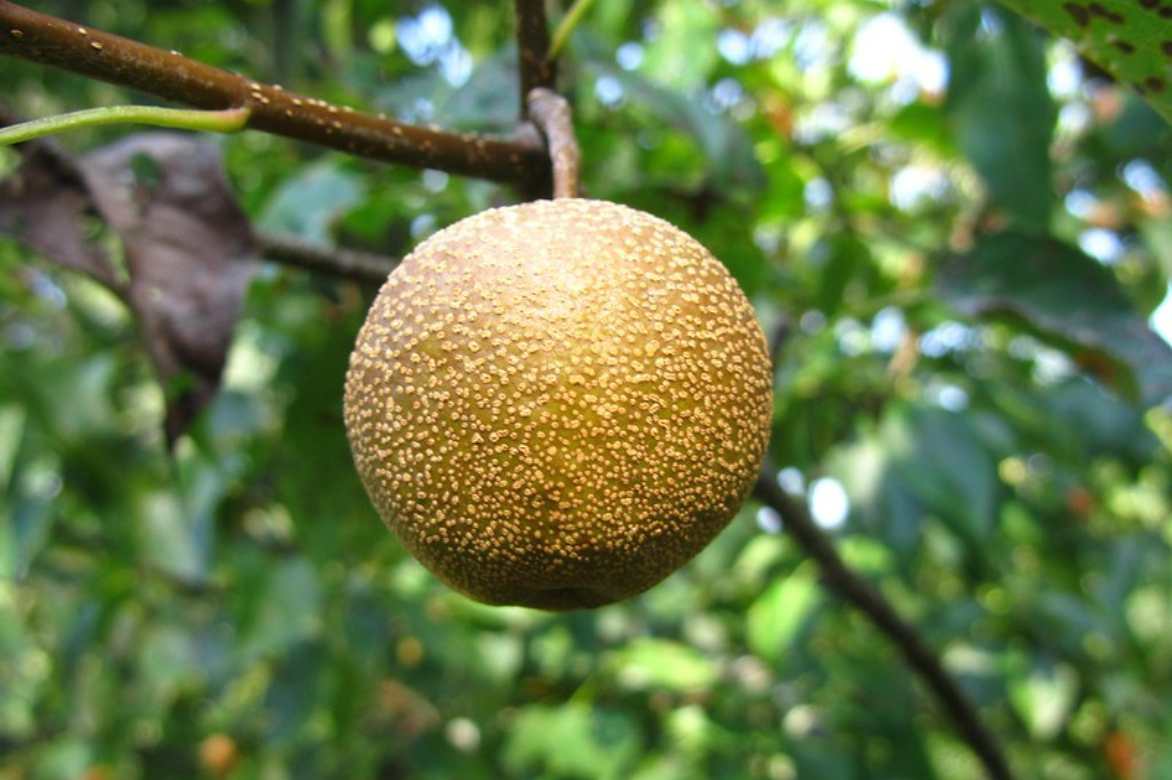
Nashi fruit (© Luka rs)
Cultivation, care, and pruning of the nashi pear
Like many fruit-bearing trees, the nashi will require some attention. During the first years after planting and in case of extreme heat, keep the soil cool at the base of the tree by watering regularly. Proper irrigation is essential for fruit production. Mulch around the base to retain moisture in summer.
Every year at the beginning of spring, apply well-rotted compost by lightly scratching the surface to maintain soil fertility. In winter, you can enrich the soil with a spadeful of wood ash, rich in potash, to improve fruit production.
If you fear late frosts on a young plant, don’t hesitate to wrap it in several layers of winter fleece.
In July, when the nashis are pre-formed, thin them out to obtain larger fruits: keep only 1 to 2 fruits per cluster, favouring the largest ones.
How to prune the nashi?
The nashi can be pruned in the same way as an apple tree, as pruning encourages new shoots. The tree bears fruit on wood that is 1 to 2 years old, so pruning should favour young shoots.
Since it tolerates repeated formative pruning well, it can be espaliered against a well-exposed wall. In this case, perform a summer pruning at the beginning of summer to shorten young shoots by two-thirds, leaving only 5 or 7 leaves after the fruit, and remove non-fruit-bearing branches.
If you are growing it as a free-standing tree, you can simply prune your fruit tree every 2 or 3 years between November and March:
- Before the growing season resumes, remove dead wood and suckers.
- Cut back branches growing inward to allow air and light to circulate.
- Every other year, prune overly long branches by two-thirds, cutting above an outward-facing bud.
- Remove any suckers growing at the base of the tree.
My advice: if the branches are too heavily laden with fruit, you may need to prop them up to prevent them from breaking under the weight.
Diseases and potential pests
The Nashi Pear tree is resistant to diseases. However, like pear and apple trees, it is susceptible to fungal diseases such as Scab and powdery mildew: treat the tree preventively in spring with Bordeaux mixture sprays. Against aphid infestations, a glue band around the trunk in early spring can be useful, as well as sprays with a mixture of water and black soap. Against the Codling Moth or fruit worm, consider installing pheromone traps in late May and attract bats and insectivorous birds, such as tits!
In overly chalky soil, your tree may suffer from chlorosis, which causes yellowing of the foliage.
Harvest of nashi pears
When and How to Harvest Them?
You will need to wait 2 to 3 years for your nashi to bear fruit after planting. The harvest of nashis begins in late August and ends in October, depending on the climate. Pick them when fully ripe, as they detach easily from the tree, as they do not ripen further after harvest.
How to Store Them?
The fruits can only be stored for 2 to 3 weeks at room temperature. You can keep them for 2 to 3 months in a crate or on shelves in a cellar, in a cool, dark room or in the vegetable drawer of the refrigerator.
→ Learn more about harvesting and storing apples and pears in our advice sheet.
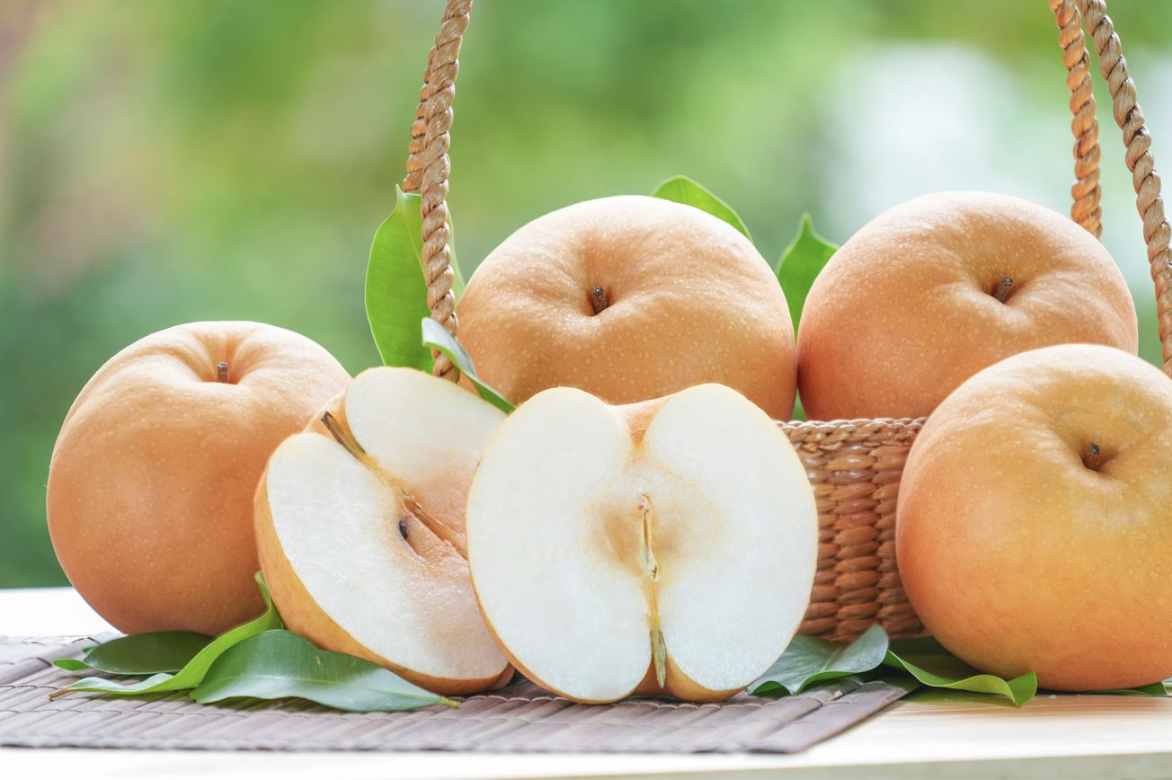
What is the taste of Nashi and how is it eaten?
The nashi has a taste similar to a pear, with juicy, tangy flesh that is not overly sweet, featuring notes of pineapple, pear, and honey.
Once peeled, nashis can be eaten like apples and pears, preferably raw rather than cooked, as they release a lot of juice. They are perfect enjoyed simply peeled and sliced with a knife. They are also delicious in fruit salads or to add a refreshing touch to a raw vegetable salad or to accompany foie gras. And why not try them as a compote, coulis, or jam! Roasted in the oven, they pair wonderfully with white meats.
What are the benefits of Nashi?
Low in sugar and low in calories (51 kcal per 100 g), the nashi is rich in water (88g/100 g), fibre, and antioxidants. It contains potassium, magnesium, vitamin C, copper, and calcium. This is the perfect combination to improve digestion, blood circulation, reduce stress, cholesterol, and cardiovascular diseases.
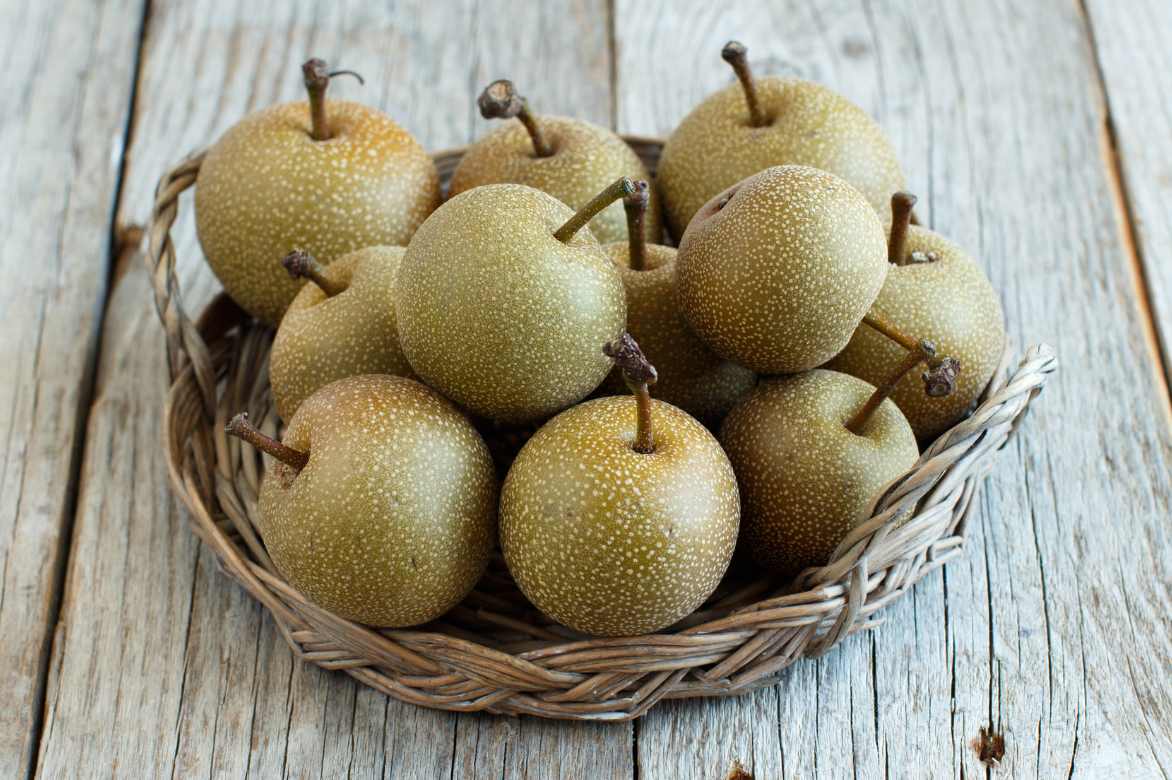
Multiplication of the nashi
The most commonly used propagation method is grafting onto a rootstock derived from closely related species. Some rootstocks are obtained by sowing pips. The most common technique is double cleft grafting, but this propagation method is reserved for professionals and experienced gardeners.
Useful resources
- How to create a conservatory orchard?
- To learn more: Choosing your fruit trees: forms and varieties
- Alternate bearing in fruit trees
- What is a rootstock and which one to choose?
- Fruit trees for beginners“
- Subscribe!
- Contents

































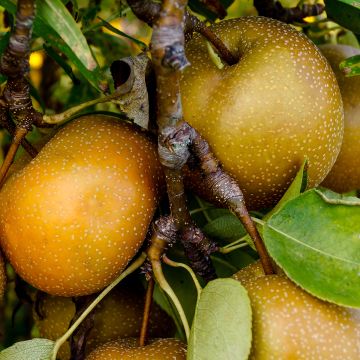
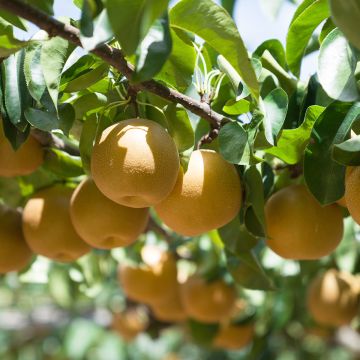




Comments